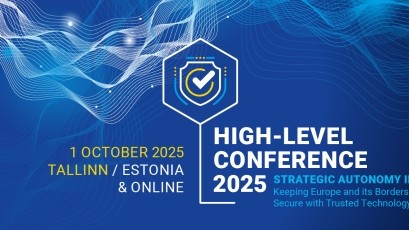Actions

By Marili Männik, Executive Director ad interim, eu-LISA
This article was originally published in Border Management Today (Issue 13) and is republished here with permission.
As Europe’s external borders experience increasing volumes of cross border movement, the EU is taking bold steps to ensure that security and mobility can go hand-in-hand. Through a combination of forward-looking legislation, innovative IT solutions and collective operational effort, the EU is building a new generation of information systems to support both seamless travel and effective border management.
The journey is being shaped by a clear strategic vision: the protection of the Schengen Area, the facilitation of legitimate travel, and the creation of an interoperable digital environment for authorities across Europe to cooperate more effectively. At the centre of this transformation lies the Smart Borders initiative and the Interoperability Roadmap — cornerstones of Europe’s evolving security and migration architecture.
A EUROPEAN VISION FOR BORDER MANAGEMENT
The legislative and political drive to modernise border management systems began more than a decade ago. The existing systems had been designed in silo and presented real challenges for end-users — particularly those working in fastpaced, security-critical environments such as border crossings or police investigations. Consequently, the EU embarked on an ambitious programme to not only upgrade existing systems and develop new ones but also to connect them — both functionally and technically. The result is one of the most complex and advanced IT undertakings in Europe’s history — designed, developed and implemented jointly by the European Commission, Member States, and operational actors such as eu-LISA.
NEW CAPABILITIES
Two major new systems are introduced under the Smart Borders package:
- The Entry/Exit System (EES), which will automate the recording of entry and exit data for non-EU nationals at external borders, replacing manual passport stamps with biometric and alphanumeric data. The EES will support better identification of overstayers and identity fraud, while reducing the administrative burden on border guards.
- The European Travel Information and Authorisation System (ETIAS), which will screen travellers from visa exempt countries before their arrival in the Schengen area. ETIAS will provide a valuable tool to assess potential security, migration, or public health risks in advance of travel.
Both systems are designed with user experience, efficiency and fundamental rights in mind, ensuring that technological advances do not come at the expense of privacy or fairness. In addition, by June 2026, eu-LISA is developing the new Eurodac, an ambitious endeavour, aimed to enhance the current system for asylum and migration management, with a set of new functionalities that will make it a complete case management tool for Member States.
INTEROPERABILITY AS A STRATEGIC ENABLER
While EES and ETIAS are critical milestones, the real paradigm shift comes from connecting all major EUlevel information systems for border management, law enforcement, and migration under a single interoperable framework. This framework includes:
- The Shared Biometric Matching Service (sBMS), which enables fingerprint and facial image matching across multiple systems.
- A unified European Search Portal, allowing national authorities to run a single search across all relevant databases.
- The Common Identity Repository (CIR), consolidating core identity data and preventing duplication.
- The Central Repository for Reporting and Statistics (CRRS), offering real-time analytics and policy-relevant insights.
Collectively, these tools allow Member States to access more complete, accurate and timely data — improving operational outcomes across border control, visa issuance, asylum management, and internal security investigations.
COLLECTIVE EFFORT ACROSS THE EU
Delivering this new architecture is not simply about building systems, it also requires a coordinated effort at national and European level to ensure technical integration, legal alignment and operational readiness.
Each Member State is adapting its national systems, upgrading its infrastructure at border crossing points, and preparing its personnel for the transition. The carrier community, especially air operators, is also playing an increasingly central role — taking on new responsibilities for verifying travellers’ authorisations before boarding.
Communicating the changes to the public is another key strand of the strategy, particularly for third-country nationals who must understand the new procedures and requirements well in advance of their travel to Europe. The interconnected nature of these tasks — spanning technology, infrastructure, legislation, and training — means that success depends on sustained political attention and operational cooperation across all stakeholders.
RECENT PROGRESS
Despite the scale and complexity of the programme, significant progress has been made in recent months. In May 2025, two major components of the interoperability infrastructure — sBMS and VIS4EES (connecting the Visa Information System with the future EES) — were successfully launched and are now in operational use by Member States. These are the first live building blocks of the Smart Borders ecosystem.
As a strategic adjustment, it has been decided to launch the EES progressively as of October 2025. This approach allows Member States to roll out the system in stages, based on their individual readiness and border traffic patterns. The objective is to achieve full functionality across all Schengen border crossing points by spring 2026.
EMBEDDING INNOVATION INTO DELIVERY
The development of these systems has also prompted EU bodies and implementing agencies to modernise their internal delivery models. Agile software development, minimum viable products, and integrated “software factory” approaches are now increasingly used to speed up implementation and improve responsiveness.
Cloud technologies, introduced through a secure and sovereign cloud strategy, are enabling faster prototyping and system scalability — cutting down on procurement delays and supporting a more iterative build process.
These innovations are being embedded into the EU’s IT governance structures and are expected to become the new standard for delivering complex, large-scale digital solutions in the public sector.
LOOKING TOWARDS A FULLY DIGITAL BORDER EXPERIENCE
The Smart Borders programme is not an endpoint — it is the foundation for a broader digital transformation of European travel and mobility. Several future developments are already being explored in parallel, including:
- Digital visas and digital travel authorisations, allowing end-toend online travel procedures.
- Biometric-only border crossings, enabling contactless and seamless traveller identification.
- Enhanced exchange of Passenger Name Records (PNR) and Advance Passenger Information (API) for better risk assessment and situational awareness.
These advances aim not only to strengthen security but also to create a smoother and more modern travel experience for passengers — fully aligned with the digital expectations of the 21st century.
By continuing to align political commitment, operational readiness and technological progress, the EU is setting a new standard for secure, digital border management — one that will serve citizens, travellers, and security authorities alike for years to come.
ABOUT EU-LISA
eu-LISA started its operations in 2012 to manage large-scale information systems in the area of freedom, security and justice.
The Agency’s portfolio includes Eurodac (a centralised fingerprints database), the Schengen Information System (SIS) and the Visa Information System (VIS), which support the implementation of the EU’s border management, migration and internal security policies.
eu-LISA’s mandate was broadened in 2018 to implement Interoperability between existing and new systems, including the Entry/Exit System (EES), the European Travel Information Authorisation System (ETIAS) and the European Criminal Records Information System - Third Country Nationals (ECRIS-TCN).
In 2024, the Agency took over the management of the cross-border justice tool, e-CODEX. The seat of the Agency is in Tallinn, (EE), while the operational management is carried out in Strasbourg (FR). eu-LISA also has a technical business continuity site in St. Johann im Pongau (AT) and a liaison office in Brussels (BE).



